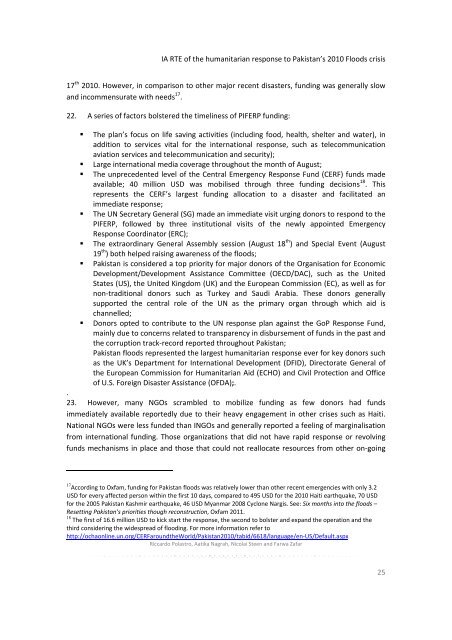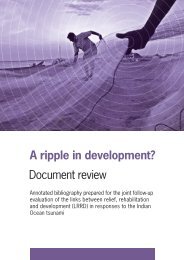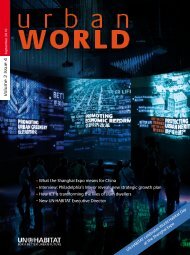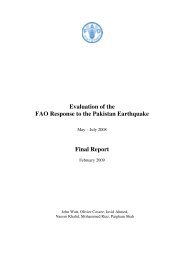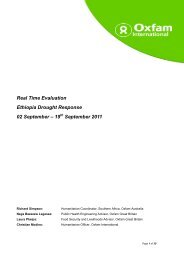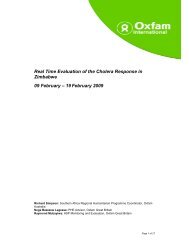Inter-Agency Real Time Evaluation of the Humanitarian ... - alnap
Inter-Agency Real Time Evaluation of the Humanitarian ... - alnap
Inter-Agency Real Time Evaluation of the Humanitarian ... - alnap
Create successful ePaper yourself
Turn your PDF publications into a flip-book with our unique Google optimized e-Paper software.
IA RTE <strong>of</strong> <strong>the</strong> humanitarian response to Pakistan’s 2010 Floods crisis<br />
17 th 2010. However, in comparison to o<strong>the</strong>r major recent disasters, funding was generally slow<br />
and incommensurate with needs 17 .<br />
22. A series <strong>of</strong> factors bolstered <strong>the</strong> timeliness <strong>of</strong> PIFERP funding:<br />
� The plan’s focus on life saving activities (including food, health, shelter and water), in<br />
addition to services vital for <strong>the</strong> international response, such as telecommunication<br />
aviation services and telecommunication and security);<br />
� Large international media coverage throughout <strong>the</strong> month <strong>of</strong> August;<br />
� The unprecedented level <strong>of</strong> <strong>the</strong> Central Emergency Response Fund (CERF) funds made<br />
available; 40 million USD was mobilised through three funding decisions 18 . This<br />
represents <strong>the</strong> CERF’s largest funding allocation to a disaster and facilitated an<br />
immediate response;<br />
� The UN Secretary General (SG) made an immediate visit urging donors to respond to <strong>the</strong><br />
PIFERP, followed by three institutional visits <strong>of</strong> <strong>the</strong> newly appointed Emergency<br />
Response Coordinator (ERC);<br />
� The extraordinary General Assembly session (August 18 th ) and Special Event (August<br />
19 th ) both helped raising awareness <strong>of</strong> <strong>the</strong> floods;<br />
� Pakistan is considered a top priority for major donors <strong>of</strong> <strong>the</strong> Organisation for Economic<br />
Development/Development Assistance Committee (OECD/DAC), such as <strong>the</strong> United<br />
States (US), <strong>the</strong> United Kingdom (UK) and <strong>the</strong> European Commission (EC), as well as for<br />
non‐traditional donors such as Turkey and Saudi Arabia. These donors generally<br />
supported <strong>the</strong> central role <strong>of</strong> <strong>the</strong> UN as <strong>the</strong> primary organ through which aid is<br />
channelled;<br />
� Donors opted to contribute to <strong>the</strong> UN response plan against <strong>the</strong> GoP Response Fund,<br />
mainly due to concerns related to transparency in disbursement <strong>of</strong> funds in <strong>the</strong> past and<br />
<strong>the</strong> corruption track‐record reported throughout Pakistan;<br />
Pakistan floods represented <strong>the</strong> largest humanitarian response ever for key donors such<br />
as <strong>the</strong> UK’s Department for <strong>Inter</strong>national Development (DFID), Directorate General <strong>of</strong><br />
<strong>the</strong> European Commission for <strong>Humanitarian</strong> Aid (ECHO) and Civil Protection and Office<br />
<strong>of</strong> U.S. Foreign Disaster Assistance (OFDA);.<br />
.<br />
23. However, many NGOs scrambled to mobilize funding as few donors had funds<br />
immediately available reportedly due to <strong>the</strong>ir heavy engagement in o<strong>the</strong>r crises such as Haiti.<br />
National NGOs were less funded than INGOs and generally reported a feeling <strong>of</strong> marginalisation<br />
from international funding. Those organizations that did not have rapid response or revolving<br />
funds mechanisms in place and those that could not reallocate resources from o<strong>the</strong>r on‐going<br />
17<br />
According to Oxfam, funding for Pakistan floods was relatively lower than o<strong>the</strong>r recent emergencies with only 3.2<br />
USD for every affected person within <strong>the</strong> first 10 days, compared to 495 USD for <strong>the</strong> 2010 Haiti earthquake, 70 USD<br />
for <strong>the</strong> 2005 Pakistan Kashmir earthquake, 46 USD Myanmar 2008 Cyclone Nargis. See: Six months into <strong>the</strong> floods –<br />
Resetting Pakistan’s priorities though reconstruction, Oxfam 2011.<br />
18<br />
The first <strong>of</strong> 16.6 million USD to kick start <strong>the</strong> response, <strong>the</strong> second to bolster and expand <strong>the</strong> operation and <strong>the</strong><br />
third considering <strong>the</strong> widespread <strong>of</strong> flooding. For more information refer to<br />
http://ochaonline.un.org/CERFaround<strong>the</strong>World/Pakistan2010/tabid/6618/language/en‐US/Default.aspx<br />
Riccardo Polastro, Aatika Nagrah, Nicolai Steen and Farwa Zafar<br />
25


